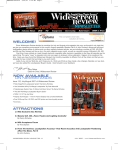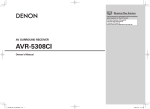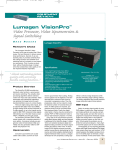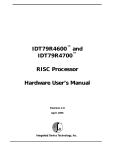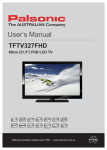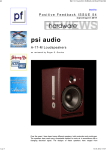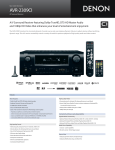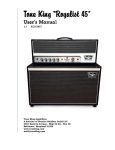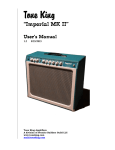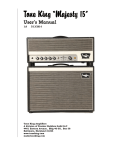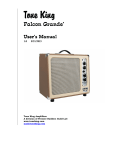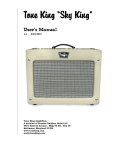Download widescreen review
Transcript
AudioControl Maestro M3 And Surround Processor Savoy G3 7-Channel Power Amplifier Doug Blackburn AudioControl has been involved in designing and making audio products for more than 30 years. The business is located in Washington state and all products are assembled in their own facilities. They make products for home theatre, of course, plus car audio and professional audio. But their home theatre focus is not typical. You will rarely or perhaps never see their products for sale in typical retail stores. Instead, they focus on custom installers to sell and install AudioControl products as part of entire custom home theatre installations. This business focus produces some interesting differences in AudioControl products versus what you would expect from typical products sold in retail stores. One difference is that there is no stated MSRP, since custom installations are contract services with a fixed price for the entire installation. If you are interested in purchasing AudioControl’s products without having to have an entire home theatre designed and installed by an authorized dealer, AudioControl says that their dealers will be more than happy to sell individual or multiple AudioControl components. To find a local dealer, go to AudioControl’s Web site, select Home Theater products, then use the “Find A Dealer” button. AudioControl estimates that the average price charged for a Maestro M3 processor in a custom home theatre installation is about $5,900, and the Savoy G3 amplifier’s price is estimated at $3,000. The main body of the review will cover the Maestro M3 processor, and the Savoy G3 amplifier will be covered in a separate sidebar. For comparisons during the review process, I used a Denon AVR-5308CI (MSRP $5,500) home theatre receiver and the Anthem Statement D2v surround sound processor (MSRP $8,495) and Anthem Statement P5 5-channel amplifier (MSRP $7,495). A Different Design Philosophy The Maestro M3 does not come with a remote control. AudioControl will supply one for additional cost, but custom installers typically provide integrated remote control solutions, often employing RS232 (serial port) connections to all the equipment in the system. AudioControl does support all the major remote control systems likely to be used in custom installations: Crestron/AMX, RTI, Pronto, Universal, Harmony, etc. One of the reasons people go to custom installers is because they can get whole-house distribution 1 Widescreen Review • Issue 149 • July/August/September 2010 systems and whole-house automation solutions so that the owner has complete multi-location control over lighting, heating/cooling, security, computer systems, and entertainment. This level of automation includes integrated controls for the home theatre equipment, so an included remote control would end up never being used or needed. Those interested in purchasing a Maestro M3 will need to discuss options for remote controls with the AudioControl dealer. Another thing that’s potentially quite different from typical retail products is that AudioControl doesn’t go overboard with obscure features, bells, whistles, settings, modes, lights, and arcane video processing menus. Everything useful is included, but because AudioControl sells the Diva room correction audio processor, the M3’s auto-setup and RoomEQ would be used in a more “basic” custom installation and the Diva audio processor would be specified for systems where the owner has more perfectionist leanings. Likewise, the video processing in the M3 handles the basics, leaving more comprehensive processing to outboard solutions. While the peripheral functions of the Maestro M3 (audio equalization and video processing) are not intended to be state-of-the-art assaults on either technology, AudioControl did focus considerable attention on sound quality, providing an all-analog signal-path option and digitally-controlled analog volume control. A digital volume control chip selects discrete resistors from a resistor array so there is no potentiometer in the signal path to degrade sound quality. High-quality 24 bit, 192 kHz DACs are used for all channels. AudioControl says their parts selection and circuit topologies were chosen to maximize sound quality, rather than to reduce manufacturing costs. Because so many custom installations involve multiple video displays, AudioControl chose to implement HDMI-to-CAT 6 conversion right inside the M3. There is a RJ-45 port on the back of the M3 to be used for running HD video up to 1080p to another video display over up to 150 feet of CAT 6 cable. When you get to your destination display, AudioControl sells the HDR-10 accessory, which has an RJ-45 input and HDMI output. An external power supply provides power for the HDR-10. I experimented with about 60 feet of CAT 6 cable that AudioControl provided for the review and that worked fine connected to a 60-inch video display in our family room. To use the internal HDMIto-CAT 6 conversion you will need to connect one of the two HDMI outputs of the M3 to the HDMI input for the CAT 6 converter. That leaves a single HDMI output for a video display or projector. 1/7 AudioControl Maestro M3 & Savoy G3 AudioControl Savoy G3 7-Channel Amplifier AudioControl’s companion amplifier for the Maestro M3 surround processor is the 7-channel Savoy G3. You’d never guess from the amplifier’s modest 56-pound weight that it could unleash 1,400+ watts of power over seven channels. Rated at 203 watts per channel, all seven channels driven, the G3 has the most power per pound of any non-digital amplifier I’ve ever encountered. The G3 achieves this efficiency through Class H operation. In conventional amplifiers, the power supply voltage always has to be higher than the highest voltage the amplifier will ever produce. In a Class H design, the input signal is analyzed, and the power supply voltage is constantly adjusted up and down so it remains just a little higher than the output voltage peaks. AudioControl’s designers use MOSFET transistors to control the power supply voltage and bipolar transistors for the output devices. A single power supply is shared by all channels, which provides extra power and headroom when the sound in one or two channels is very powerful, but other channels are much quieter. As a result, the G3 can produce peak levels in excess of the 203-watt continuous all-channel power rating. The shared power supply is common practice in many amplifiers, including most AVRs. But Class H operation is not particularly common. Some purist amplifier designs have individual power supplies for each channel, even though that could limit power when more is needed by one channel. There’s no guarantee that multiple dedicated power supplies is better than a single shared power reservoir. Much depends on the design features of each circuit. Each of the G3’s channels has both RCA and XLR (balanced) inputs and a sensitivity switch. AudioControl recommends the default “C” position for the sensitivity switch, unless the system requires more input sensitivity. The “C” position produces the lowest noise floor. The “B” position matches THX® specifications for input sensitivity. The “A” position is for rare processors, which may have limited output voltage. Each channel has an RCA output jack also. This is a first in my experience. The stated purpose for the output jack is to facilitate bi-amplification. The output of the front left channel could be sent to the input of the left rear surround channel, and both the left front amplifier channel and left rear surround amplifier channel could be connected to the left front loudspeaker provided that loudspeaker has a dual set of posts/connections to support bi-wire or bi-amplification. If all the loudspeakers have bi-wire/bi-amp connections and more power is needed than the G3’s 203 watts/channel, an entire second G3 could be used with jumpers from one amplifier to the second amplifier. The binding posts AudioControl chose are a real pain to use with spades. They are completely plastic-enclosed except for a small slot that faces left (as viewed from the back of the amplifier). Your spade connector cannot be slipped into this opening since it is too small. You can only get one leg of the spade into that opening. When you tighten down the binding post, it grips just one leg of the spade connector. Vibration or jostling of the cable loosens hand-tightened posts on the single prong of the spade rather easily, so if you must use spades, you may want to tighten the posts a little tighter than finger-tight. While these posts more easily accept bare wire or pins, banana plugs are, by far, the easiest-to-use terminations with these “safety posts.” The only other features on the back panel are a master power switch, a fuse holder, a 12v trigger input, and the IEC power cord socket. The G3’s front panel matches the M3’s high-gloss black appearance, with a slightly raised perimeter “frame.” There’s a front panel power switch, a display mode button, amp protection indicator, and seven sets of LEDs, one set for each channel. The channel indicator LEDs include a status light that is normally blue but turns red if that channel is shut down for any reason. Five more blue LEDs are stacked above each of the status LEDs and those illuminate in response to the amount of power each channel is delivering. The bouncing power indicator LEDs can be disabled with the display mode button. A rack mounting kit is optional for the G3. AudioControl says the price quoted in a typical custom installation proposal for a Savoy G3 amplifier will be $3,000. That means the G3 amplifier channels cost about $430 each. The Anthem Statement P5 amplifier (MSRP $7,495) costs about $1,500 per channel. And the amplifier channels in my stereo reference amplifier are more than $2,000 each (Belles/Power Modules 350A Reference). Give the differentials here, you might expect the Savoy G3 to be handily outclassed by either the Anthem Statement amplifier or my stereo reference amplifier. Imagine my surprise when the Savoy G3 turned out to be among the best-sounding amplifiers I’ve ever heard. It is so good, that the first afternoon it arrived I spent five hours doing nothing but listening to music. And the G3’s immediate predecessor in the system was the Anthem Statement P5 amplifier. I would have been uncompelled to listen to any music that afternoon had the Statement P5 amplifier still been in the system. The G3’s sound was so immediately compelling, I couldn’t stop listening to music. New albums I’d never heard before (Toto’s IV on Mobile Fidelity Sound Labs and The Tornadoes’ Bustin Surfboards ’98 on the DCC audiophile label) surprised me so much with the compelling top-to-bottom rightness of the sound that I listened to both albums all the way through. I began to queue-up familiar reference tracks from XTC’s Apple Venus Vol.1 and was simply blown away by how incredibly good this amplifier sounded playing this great music. The tone of the piano was just the right combination of hammeron-string and sustain. Too often, recorded piano sounds like something is missing, but not with the G3. The bass octaves, as reproduced by the G3, have more depth than I’ve heard in this system before. By “depth” I mean the sense of apparent distance from the microphone…close to far away. Some bass sounds seemed quite distant from the microphone, while others were The M3 has two more RJ-45 video outputs, one for composite or SVideo on CAT 5 cable up to 1,000 feet to Zone 2. The other connection is for Component video over CAT 5 cable, also up to 1,000 feet, for the main zone. Optional accessory receivers are needed for each display connected to one of these connections. The BVR-20 is for component video, and the BVR-10 for composite/S-video. The Maestro M3 is the only current surround sound processor with built-in video over CAT 5/6 capabilities. Other solutions exist, but they require double the hardware (i.e. an encoder and a decoder for each display) and rely on a third-party solution that may or may not be as stable as AudioControl’s own solution. framing the smooth flat front panel. A good-sized electroluminescent display has an especially large volume level display. A large, smooth-operating volume control knob is located to the right of the numeric/text display. There are 10 buttons on the front panel, but they are barely visible. Illuminated blue text lights up above each button, except Standby, which has red illumination. The small domed buttons barely protrude from the front panel. The result is an extremely clean and uncluttered front panel. I don’t often comment on styling of components, since most are fairly interchangeable, with little to distinguish one from another, but the Maestro M3’s high-gloss black front panel looks distinctive and classy. The back panel of the Maestro comes very close to perfection. Most of the back surface is painted white. This is so logical and right that it ought to be a law that all home theatre products have white back panels. The only detail that’s not “perfect” is the gray printing for the labels instead of black. That lowers the contrast enough that you still need a flashlight Appearance And Product Description The Maestro M3 has a unique appearance that won’t be mistaken for anything else. A high-gloss black front panel has a slightly raised perimeter 2 Widescreen Review • Issue 149 • July/August/September 2010 2/7 AudioControl Maestro M3 & Savoy G3 much more forward, close to the perceived location of, say, the lead singer. I can’t recall such clarity in the front-back location of bass sounds from any amplifier, let alone one this reasonably priced. The next thing I noticed was that the tail-ends of sounds (decay, echo, reverb) had a naturalness and clarity to them that I don’t hear very often. Most instruments’ sounds are a complex mix of primary and harmonic frequencies. The G3’s harmonics had more flesh to them…more substance, more reality. Best of all, there was absolutely no hint of “solid-state sound.” People who claim to dislike the sound of solid-state amplifiers say it is because the sound is too mechanical and because high frequencies have some grit, or edginess, or glassiness to them that is not natural. The G3 has none of those properties. In amplifiers in this price range, I often hear sonic limitations that are relatively obvious compared to more expensive products, but the G3 holds its own with the best amplifiers I’ve heard so far. I had been listening to the G3 amplifier for about three hours before an e-mail arrived telling me what the typical price that it would be listed for in a custom install proposal. I had decided it was probably going to be $6,000 or a little more. I was very surprised to find out the actual cost would be half or less than half of what I was expecting. Switching to movies, the sound was every bit the equal of what I heard when listening to stereo music sources. The surround envelopment was great, with fantastic amounts of detail. Ambient sounds were especially spooky while watching The New Daughter and The Wolfman. The sense of space was excellent, with the size of the space always conveyed very well. When the soundtrack was particularly well done, the sense of being inside the space with the movie action was very convincing. The clarity and harmonic completeness/correctness provided very convincing illusions of reality on numerous occasions. It’s not that other amplifiers have been “worse” in any obvious way, it’s more an issue of the G3 being more convincing. In Quantum Of Solace, the foot chase through the tunnels, into the horse race crowd, across the ceramic tile roofs, through the skylight, and the fight on the scaffold and ropes inside the building is an excellent example of how well the G3 can reproduce a complex and dynamic soundtrack mix. The intensity of the music, combined with great and perhaps reading glasses (you all know who you are) to read the labels. But the white surface makes identification of various connections much easier than the typical home theatre processor with black back panels. The area around outputs is black with white lettering, so it is easier to identify the areas of the back panel for output connections. There is much less black area than white area, so all that white paint still makes everything easier to see once the M3 is put in an equipment rack. The AC power cord is removable via an IEC socket, allowing the use of replacement power cords if desired. There’s a main power switch on the back panel making it easy to shutdown when you are working in the back. Inputs are named (AV, SAT, DVR, CD, DVD, etc.) instead of being numbered. But this doesn’t really impact setup in any significant way. Other connections on the back panel include five HDMI inputs, 7.1 analog inputs (non-processed, volume control only), and 7.3 analog outputs with both RCA jacks and XLR connectors. There’s an input jack for the audio measurement microphone, an IR jack for each of three zones, and a 12v trigger for each zone. An Ethernet jack and USB connector (type A female) support Internet functions and digital files from a variety of storage devices. An RS-232 connector supports automation systems and can be used for firmware updates using a computer to send the update. I did perform a firmware update during the evaluation period. The RS-232 connection required a USB-to-Serial adapter. I used a Keyspan model that is about two years old and it worked fine. The headphone jack is a 1/8-inch jack on the back panel that works differently than most you’ve probably 3/7 Foley work, real crowd sounds, and amazing choreography of action produces a rush of excitement that is driven by the great sound quality of the G3. The sounds of breaking ceramic roof tiles and the shards sliding down the sloped roofs stood out cleanly from the dynamic driving music. The music itself is revealed to be very well recorded, with rich harmonic content and great detail. Individual instruments were clearly identifiable and were extremely dynamic. The tension created by the music was strong enough to cause a pulse-racing adrenaline rush even on back-to-back viewings of the chase and fight. If the 6 ohm average, 3 ohm minimum Vandersteen 3A Signature main loudspeakers were taxing the Savoy G3’s 4 ohm minimum loudspeaker recommendation, I would expect a significant and audible improvement in sound quality when bi-amplifying the 3A Signatures instead of using one amplifier channel per loudspeaker. It only took 30 seconds or so to tell there was no benefit to bi-amping the main loudspeakers. Perhaps with less-efficient loudspeakers or when there’s a need to fill a larger space with sound, the bi-amping feature would be helpful. But for most loudspeakers in average-size rooms, bi-amping with the G3 is probably overkill. The Savoy G3 is a killer value. I’ve never experienced an amplifier that gives this much listening pleasure from so many channels for such a modest cost. And it’s not just “great for the price,” it is a great-sounding amplifier regardless of its price. I haven’t heard an amplifier at any price I’d rather listen to than this amplifier. encountered. Most AVRs and processors have front panel headphone jacks that disable the main zone (aka Zone 1) when you plug in headphones. AudioControl’s headphone jack leaves Zone 1 operating. Muting Zone 1 does not mute the headphone jack. This allows some flexibility in custom installations that you can’t get from a conventional headphone jack. As is fairly common practice, Zone 3 is audio-only, while Zone 2 can send audio and video. The Maestro M3’s User Manual is a pleasure to read and use compared to typical translated manuals supplied with many products. The manual itself isn’t huge, but it is dense with information. This isn’t a manual you breeze through. Every sentence contains information; you have to make sure you read each sentence. The M3 currently ships with HDMI v1.3, but HDMI v1.4 will ship early in 2011, and AudioControl will have an upgrade program to convert existing M3s to HDMI v1.4. At this time, the only reason you would need HDMI 1.4 is that most home 3-D signals won’t pass through an HDMI 1.3 interface. Some 3-D disc players include two HDMI outputs so one can be connected directly to the video display while the other is connected to the HDMI 1.3-equipped surround processor, so HDMI 1.4 is not an absolute necessity. Network And USB Features The Maestro M3 will play Internet radio stations and let you build a “favorites” list, as you find stations you enjoy. The only limitation you’ll www.WidescreenReview.com • Issue 149 • July/August/September 2010 3 AudioControl Maestro M3 & Savoy G3 Features - Maestro M3 surround processor HDMI 1.3: 2 out; 5 in (HDMI 1.4 update available in 2011) Analog stereo (RCA): 7 inputs, tape out, Zone 2 & 3 stereo out 7.1 analog inputs (RCA), analog pass-through only 7.3 Analog outputs (RCA and XLR) Digital Coax: 1 out; 3 in TosLink optical: 1 out; 4 in Analog Video Inputs: 5 component; 5 S-video; 5 composite Analog Video Outputs: 1 component; 3 S-video; 3 composite Zone 2 Outputs: Analog Stereo (RCA), component, S-Video Zone 3 Outputs: Stereo audio only Rear panel Ethernet and USB connections Supports 44.1, 48, 88.2, 96, 176.4, or 192 kHz sample rates with 16 to 24 bits Supports and/or decodes: PCM, Dolby TrueHD, Dolby Digital Plus, DTS-HD MA & HR and legacy codecs; does not include Dolby Pro Logic IIz Output audio modes include: stereo pass-through or processed, 5.1, or 7.1 with or without: Dolby Pro Logic; Dolby Pro Logic IIx Music/Movie/Matrix/Game; DTS Neo:6 Music/Cinema, stereo downmix Dolby Volume (with Leveler) available for all sources except when using Direct mode or multi-channel analog inputs Network/USB Audio function directly supports digital audio file formats: MP3, WMA, WAV, FLAC, MPEG-4 /AAC, Ogg Vorbis Internet Radio support built-in Auto Speaker Setup with RoomEQ Zone 2 – analog stereo RCAs Headphone jack on rear panel RS-232 support (back panel) 3 12v trigger jacks, 1 for each zone IEC AC power connection Back panel jack for setup microphone (microphone included) All video input signals can be upconverted to 1080p HDMI Built-in HDMI-over-CAT 6 up to 150 feet (requires optional HDR-10 CAT 6 to HDMI converter) Built-in Component/S-video over CAT 5 for Zone 2, up to 1000 feet (requires optional BVR-20 converter unit at destination) Built-in Composite/S-video over CAT 5 for Zone 2 (requires optional BVR-10 converter unit at destination) IR Inputs: 1 per zone IR repeater output (combines all zones) Back panel on-off switch Features – Savoy G3 7-Channel Amplifier 12v trigger input Protection against: clipping, over temperature, short circuit, DC offset RCA and balanced XLR input connections for all 7 channels Gold plated 4-way insulated speaker cable binding posts: spade, banana, bare wire, pin Front panel channel level display, defeatable IEC AC power cord connection Rack mount brackets optional Class H operation RCA output for each channel facilitates bi-amping find here is that there are so many radio station choices, and navigation is slow/deliberate enough that working through the large list of choices can be time consuming. But using the Favorites list makes that navigation issue mostly a one-time chore. The M3 will directly play MP3, WMA, FLAC, MP4/ACC, and Ogg Vorbis files sent via an Ethernet or USB-connected device. Smaller libraries are easier to deal with, as the slow navigation speed can make getting to what you want to play in the middle of a large directory/library time consuming. This slow navigation issue has been common to every net/USB-capable AVR or processor I’ve used so far, so it’s not really a surprise here. The best solution for accessing a large library stored on a hard disk is still a media server PC running something other than Windows Media Player (WMP is bog slow with large libraries), or if you have a PS3, it can become your media server using free software (PS3 Media Server) running on your Windows laptop or PC. It was essentially no work at all to get the M3 connected to my network or to use USB storage devices. Since the USB port is on the back, a male-to-female USB cable run to a convenient location would help if the back of the M3 is not readily accessible. Internet radio isn’t exactly a high-res source, but the various stations had acceptable sound quality. Interruptions were possible if there 4 Widescreen Review • Issue 149 • July/August/September 2010 was other network activity, but that’s common to any device playing Internet radio stations. Sound quality of digital music files sent by a PS3 via HDMI or via Ethernet was as good as the original discs played on a high-quality disc transport with the M3 decoding the digital audio or with a high-quality 24/192 outboard DAC doing the decoding, with the M3 handling the analog audio via the Direct all-analog signal path. Digital music files sourced from higher-quality discs retained all the audiophile characteristics that make them sound so good. Depth, width, clarity, detail, rich harmonics, pristine high-frequencies, and sounds that exist in easily identifiable (and stable) locations are all at least as good as the sound from the original discs. One difference between the M3 and some other processors, like Anthem’s Statement D2v, is that the D2v up-converts every source to 24/192 no matter what the input bits and sample rate were. The M3 plays digital files in whatever format they are received. 16/44.1 files from CD stay 16/44.1 through the M3, but if your disc player (like a PS3) up-converts those files to 176.4 or 192 kHz, the M3 will play them in that format also. A firmware bug initially prevented the M3 from playing 176.4 or 192 kHz sample rate music files, but near the end of the review period, a firmware update fixed the glitch. Sending higher sample rates definitely sounded better that sending the files in their original format (like 16/44.1). It wasn’t a huge difference, but any listener tuned in to small sonic differences and improvements would notice without any difficulty. So my advice would be… when you can send higher-bitrates to the M3, do it. You’ll get sound that’s a little better in regards to overall clarity, the smoothness and detail in high frequencies, and in the sense of space and open-ness within the recording. Auto Setup And RoomEQ AudioControl provides a measurement microphone quite different than most. It’s a 4-inch diameter disc with a slightly domed top surface of perforated metal. The microphone itself is sturdier than the plastic “tower” type microphones provided with many AVRs and processors. The microphone is intended to face the ceiling with the AudioControl logo towards the center channel loudspeaker, and presumably towards the center of the screen or panel display. I found that the Auto Setup worked fine with a 5.1 loudspeaker setup, but when additional surround channel loudspeakers were added for a 7.1 system, the M3 consistently set those channels about 4 to 5 dB louder than they should have been set. This was confirmed by listening, measurements, and comparing settings arrived at with other surround processors and AVRs. Manually changing the auto setup values is easily done in the loudspeaker levels menu. The M3’s RoomEQ function, like most, focuses on bass octaves and midrange where room dimensions and loudspeaker placement can cause peaks and dips in frequency response. Response dips caused by cancellations can’t be fixed by AudioControl’s (or anybody else’s) RoomEQ since boosting power at the center of the dip just makes the cancellation stronger. So, like all room EQ software, AudioControl is limited to shaving off the worst response peaks without going too far. When you run Auto Setup, do run the RoomEQ calculations because after a RoomEQ calculation is saved in memory, you can turn it on and off for each source/input. I found RoomEQ ON produced an average wide-band SPL measurement that was 4 to 5 dB louder than RoomEQ OFF. So if you are comparing the sound of the OFF/ON modes, be sure to compensate (4.5 dB should be pretty close) for the difference in loudness. People will just about always say something that’s louder is better-sounding, even if it isn’t. My experimentation with RoomEQ on and off favored having it turned off. That’s somewhat surprising as I have (mostly) enjoyed Audyssey MultEQ XT in the Denon AVR-5308CI AVR and the Trinnov system in the Sherwood Newcastle R-972 AVR, at least to the point of being a good-sounding alternative to having those EQs turned off. With the M3, I preferred the clarity and balance of the system with RoomEQ 4/7 AudioControl Maestro M3 & Savoy G3 turned off. My room is equipped with 14 wall-mounted, very slightly absorptive room acoustic devices and four free-standing room acoustic devices (Helmholtz resonator type products with minimal absorption). With a room like this, perhaps AudioControl’s Diva audio processor would produce more consistently improved sonic results. Perhaps you have occasionally listened to music and felt that bass frequencies just doesn’t have the power or volume level they should have when you’re in the mood for something approaching the power of the bottom end at live concerts. The M3 has a pretty simple solution for that, especially if you have full-range main front loudspeakers. For stereo sources you can choose the purist stereo mode or you can choose what AudioControl calls “left/right+subwoofer.” In this mode, the M3 sends full-range bass to the main loudspeakers then sends the same full-range bass to the subwoofer, essentially doubling-up on the bass. Though this sort of “doubling” of bass doesn’t sound like the bass is “twice as loud.” It’s more like a 3 to 6 dB bass boost without using the bass control. It was kind of addictive for those times when absolute fidelity to the source wasn’t the main listening goal. Video Processing As mentioned earlier, there’s nothing out of the ordinary regarding the M3’s video processing. Upconversion from 480 to 1080 is about average for what I see in AVRs, processors, and Blu-ray Disc players. The M3’s DVD upconversion leaves some grain, visible aliasing, and scan lines, all of which are rendered almost invisible by OPPO’s Anchor Bay video processing in the BDP-82 Blu-ray player. The Lumagen Radiance processors make DVD look better still. The M3’s video adjustments are limited to several noise reduction modes, edge enhancement, brightness, contrast, and color. There are no gray scale or CMS controls. All sources are correctly converted and up-res’d from any video input to HDMI, but HDMI-in to component (or S-video or composite) out appears to put the component signal in Rec 601 (standard def) color space even though you may want Rec 709 (HD) color space. This isn’t a particularly serious issue since few owners/installers would use HDMI inputs with component outputs in the main zone in a new system…at least I hope not. HDMI has evolved into a (mostly) reliable connection in systems consisting of newer components. Standard-definition component video to HD component video conversions are done correctly. AudioControl urges using multiple connections for various sources when setting up multi-zone configurations, to provide extra flexibility when sending signals to Zone 2 or 3. The M3’s Blu-ray Disc images look as good as any processor, so long as none of the processing controls are enabled. The M3 will “pass” high-quality HD video without changing anything…something that can’t be said for all video processing-equipped AVRs and processors. The M3’s video processing was comparable to the Denon AVR5308CI, but the Anthem Statement D2v had better and more comprehensive (and more complex) video processing that produced better results with upconverted DVDs. Analog Audio Multichannel analog audio is handled in a purist way by the M3. The 7.1 analog inputs are sent through a 100 percent analog signal path with analog volume control directly to the M3’s outputs. This means no processing of the multichannel inputs. If you want or need full processing, your disc player would have to have a full array of loudspeaker and crossover settings…distance, level, crossover frequency, loudspeaker size, etc. Stereo analog inputs can be converted to digital, fully processed, and converted back to analog for playback. But there’s also a purist analog mode called “Direct” mode with a 100 percent analog signal path that even turns off all the digital signal processing for good measure. I found that the direct mode did sound better than the non-direct (i.e. digitized) 5/7 Specifications – Maestro M3 surround processor Dimensions (WxDxH) – 17 x 7 x 16.5 (inch) Weight – 27 lbs MSRP – none stated, but itemized custom install bid proposals will typically show $5,900 Power requirement: 115/230 VAC, 50 or 60 Hz, switch selectable Power consumption: 3 watts standby, 25-50 watts operating Signal to Noise Ratio: -100 dB Frequency response: 20Hz-20kHz Made in USA 5 year transferrable warranty, parts and labor Options: HDR-10 HDMI extender – estimated price $200; BVR-10 composite/S-video extender estimated price $110; BVR-20 component video extender estimated price $150 Specifications – Savoy G3 7-Channel Amplifier Dimensions (WxDxH) – 17 x 7 x 16.5 (inch) Weight – 56 lbs MSRP – none stated, but itemized custom install bid proposals will typically show $3,000 Power requirement: 117VAC, 60Hz Power consumption: 1430 watts peak; 150-250 watts typical operating; 1 watt standby 203 watts @ 8 ohms, all channels driven Recommended minimum speaker impedance: 4 ohms Frequency response: 10Hz-100kHz +/- 3 dB THD: less than 0.08% at rated power into 8 ohms 20Hz-20kHz Signal-to-Noise ratio: greater than 110 dB at full power, A-weighted Slew rate: 50V/ms Damping Factor: greater than 450 Input impedance: 22,000 ohms Made in USA 5 year transferrable warranty, parts and labor Manufactured By: AudioControl 22410 70th Avenue West Mountlake Terrace, Washington 98043 425 775 8461 425-778-3166 Fax Web site: www.audiocontrol.com Email: [email protected] mode when listening to CD-quality or better-than-CD-quality music. Many Asian products offer direct modes also, but the M3’s direct mode makes a rather obvious improvement in sound quality, while the Asian products’ improvements are much more subtle. Selecting the M3’s direct mode immediately sounds more spacious, transparent, and detailed. In fact, it sounds very similar to my reference stereo preamplifier. I used the Maestro M3’s moving magnet phono input with my trusty Roksan Corus Black moving magnet cartridge mounted in an SME V tone arm installed on a Roksan Xerxes turntable and was quite pleased with the result. The sound was actually enjoyable and “worthy” of the M3’s overall performance. My reference in this case is a far more expensive low-output moving coil cartridge and the high-gain moving coil phono stage in my stereo preamp (Belles/Power Modules 28A). There was no way the moving coil setup could be approached by the moving magnet setup, but if you aren’t looking for the ultimate in LP playback, the M3’s moving magnet phono stage is far more enjoyable than those found in any Asian-brand AVR or processor I’ve heard so far. In fact, the phono stages in most surround-oriented components sound like cheap afterthoughts. At least the M3 offers phono performance you can enjoy if really good moving magnet cartridge playback of LPs meets your needs. The M3’s sound with analog sources was very obviously better than the Denon AVR-5308CI when both were using the same outboard amplifier. The M3 has a clarity and openness to the sound that the Denon just can’t match. The Anthem Statement D2v was much stiffer competition. I would call the evaluation a draw, but they don’t sound the same. The D2v has a little more energetic sparkle to the sound that makes it easy to hear subtle detail, while the M3 has a prettier, richer sound. I could live happily with either one. Digital Stereo Inputs There are design decisions facing every manufacturer of home theatre products. When it comes to digital audio, one of the questions you www.WidescreenReview.com • Issue 149 • July/August/September 2010 5 AudioControl Maestro M3 & Savoy G3 have to decide on is whether you are going to upconvert all inputs to 24/192 or whether you are going to process incoming signals in the format that they arrive. AudioControl chose the latter. I found that sending higher sample rate digital stereo music sounded better than if I sent native 44.1 kHz CD digital files. At 88.2 kHz the sonic “upgrade” was worthwhile and at 176.4 kHz put just a little more luster on the sound. The stereo layer of SA-CDs played back as 24/192 PCM via HDMI into the M3 produced some of the most involving stereo listening I’ve had in quite some time. The M3 advantages over the Denon were obvious enough that they would be difficult to miss. The M3’s bass was stronger, as if the M3 had better control over all the bass octaves. This produced more solid and exciting bass transients, as well as more detail within various bass sounds. The M3’s midrange clarity was easy to hear. Everything from vocals to guitar to piano and violin were cleaner, clearer, more detailed, and more harmonically rich than the Denon’s presentation of the same tracks. The M3’s entire top-end was far more pristine, crystalline when appropriate, and just plain prettier. The M3’s superior resolution and smoothness with- “The M3’s major strength is the high-quality analog and digital audio sound quality that’s equal . to,though not identical to,the best I’ve heard from any surround processor.” A firmware bug prevented the M3 from playing stereo sources higher than 96 kHz sample rate for much of the review period, but near the end of the review (late July 2010), I downloaded a preliminary firmware update that restored the M3’s ability to accept 176.4 and 192 kHz stereo digital files. In the Input Config menu page, there is a Mode setting that lets you specify how you want the M3 to present stereo sources. You can select from Dolby ProLogic IIx modes, DTS Neo:6 modes, Stereo, or Last Mode. Your choice here will only set the default mode, there is still a button on the remote control to set stereo mode, PLIIx, or Neo:6. If you choose one of the PLIIx or Neo:6 modes, you’ll get 7.1 sound from stereo sources if you set up seven loudspeaker channels, or 5.1 sound if you set up five loudspeaker channels. Stereo mode was used for all the stereo music evaluations. Though both PLIIx Music and Neo:6 Music modes also sounded great for casual listening when a little more immersive sound is pleasant. When playing digital files sent at 88.2 kHz or higher (upconverted from the original sample rate by a component like a PlayStation®3 or by media server software) the M3’s sound quality was head and shoulders above lower-cost AVRs or processors. The M3 sounds considerably better than Denon’s flagship AVR-5308CI when both were using the same amplifier, so the Denon’s internal amplifiers were not part of the playback chain. Setting up this comparison took some thought so that both products were on even footing in regards to what was enabled and what was not. I turned off everything in the way of processing and let the two products convert the digital files to analog and run the analog signals through their output sections. There really wasn’t anything the Denon did better or even as well as the M3. 6 Widescreen Review • Issue 149 • July/August/September 2010 out any veiling or thickness was also quite easy to hear. All that said, the Denon really doesn’t sound bad, without putting it in direct comparison to the M3. But the direct comparison is really lopsided towards the M3. The Anthem Statement D2v processor has an advantage in spaciousness, noise floor, transient speed, and detail. The M3 has slightly richer harmonics that cause an emotional bond with how “pretty” the music sounds. Anthem Statement D2v and M3 both had intermittent noise blips when using the PlayStation 3 as a music server for digital files. After starting the PS3 Media Server software on my laptop, the PS3’s menu detects the media server, and I can browse the folders on my external hard disk to select music to play. The PS3 was connected to both processors with an excellent WireWorld Silver Starlight HDMI cable. Both processors experienced occasional pops (low frequency) when changing from one album to another at the beginning of the first new song. The M3 also experienced an occasional odd digital noise that sounded for all the world like the good old days when you would lower a stylus a little too close to the edge of an LP and it would slip off the outside edge of the LP. The Denon never hiccupped with the same playback chain. And the PS3 always worked with perfection when playing Blu-ray Discs to either the M2 or D2v, so there was clearly something different happening with the stereo digital music files. Digital Surround Sound The M3’s performance with digital surround sources via HDMI, coax, and optical connections was as good as the best I’ve heard from any surround processor, including the Anthem Statement D2v. Dolby TrueHD and DTS-HD MA soundtracks were both reproduced with great fidelity, regardless of whether they were sent to the M3 as TrueHD or DTS-HD bitstreams, or decoded in the player and sent as multichannel linear PCM. The ambient sounds in The Wolfman were just right, building tension or creating realistic settings like the gypsy camp or inside the pub. Interior sound was appropriate for the size of the room. Somewhat dead inside the low-ceilinged pub and large and echoed inside the estate house. Gunshots and chase scenes were appropriately intense and believably accurate to Victorian-era guns and 6/7 AudioControl Maestro M3 & Savoy G3 vehicles. The great soundtrack from Terminator: Salvation was every bit as clean, clear, intense, and enveloping as I’ve experienced from any surround processor. The dynamics of the title music were great, building to a powerful intensity, twice. Dialogue was pristine and clear, even during the first action sequence of the attack on the Skynet base. The impact of explosions was visceral, with all the detail of each event producing unique sounds rather than repeating the same boom-boombang over and over again. Subtle detail, like the ambient sounds inside the submarine, were clear and detailed without being too obvious. Digital surround in Dolby Digital and DTS formats delivered to the M3 via coax were excellent, considering the limitations of these formats. The sound quality I got from DVDs equaled the best sound from these tracks I’ve gotten from any surround processor or AVR. Dynamics and detail were both excellent, to the point that you were not constantly reminded you were listening to relatively highly-compressed audio tracks. Some AVRs and surround processors that support seven audio channels have no facility for you to select no rear channel surround loudspeakers for 5.1 soundtracks. It seems that once you set up the rear channels, you have to pick from Dolby ProLogic IIx or DTS Neo:6 and accept the synthesized rear surround mix from 5.1 soundtracks. The Maestro M3 has a “None” option for the Ext. Mode setting (Input Config Menu). Ext. Mode sets the default surround sound mode for surround sources. If you always want to use Dolby ProLogic IIx, you could set that in the Ext. Mode and you’d always have 7.1 sound from every soundtrack. However, some movie purists want to hear 5.1 sound from 5.1 discs and 7.1 sound from 7.1 discs, and that “None” option for Ext. Mode is what you want to use to keep the number of playback channels equal to the number of channels in the original soundtrack. While the Denon AVR-5308CI sounds good on the same soundtracks, when you revisit the same scenes with the M3, there’s an intensity and reality to the sound that the Denon can’t quite match. The difference requires the back-to-back comparison to detect, though. The Anthem Statement D2v processor was very close to the M3’s sound quality. The D2v had just a hair more clarity in the echo inside the mansion and in some of the fine detail, but it took a lot of switching back and forth to find that small difference. Most things sounded so similar between the two products that it wasn’t possible to declare a “winner.” Crestron/AMX, Universal, Harmony, or Pronto codes, or budget a little extra to add one of those remote systems. Combined with AudioControl’s Savoy G3 7-channel amplifier, the M3 easily exceeds the best performance I’ve heard from flagship Asian AVRs. There’s more clarity, better detail, better loudspeaker drive capability, and a richer, more musical sound than any Asian AVR has been able to deliver, so far. The far more expensive Anthem Statement D2v/P5 combo (roughly twice as expensive, with seven Anthem Statement amplifier channels) sounded excellent, but did not clearly outclass the AudioControl products. The Anthem Statement setup did benefit from better and more comprehensive video processing and better on-board Room EQ capabilities. But the AudioControl setup has network/Internet capabilities and distributed video capabilities that the Anthem setup did not have. The Maestro M3 provides performance appropriate for its (expensive) price. At this price point, you should expect excellent sonic performance, and the M3 does deliver on those expectations. The biggest surprise I had during this review was the performance of the Savoy G3 amplifier. The modestly priced 7-channel amplifier provides remarkable sound quality––easily as good as any multichannel amplifier I’ve heard at any price. I can’t recommend the circa $3,000 G3 7-channel amplifier highly enough. WSR Provided By Conclusion The AudioControl Maestro M3, while expensive, delivers top-tier analog and digital audio performance. It is sold only through custominstaller channels, so it’s not likely to be available from typical retail equipment sources, though AudioControl installer/dealers are happy to sell components without custom design/install services. The Maestro M3 is an excellent analog preamplifier, as well as having true high-end digital audio performance for both stereo and surround sources. The video upconversion capabilities are just average, but HD sources are as good as they get, which means “unmolested” in this case. The M3’s Room EQ is fairly basic, and those more serious about getting the best possible Room Equalization should consider AudioControl’s Diva audio processor. Net/USB functions work well but navigation of large numbers of choices is slow, as has been the case in every Net/USB ready processor or AVR I’ve evaluated so far. The M3’s major strength is the high-quality analog and digital audio sound quality that’s equal to, though not identical to, the best I’ve heard from any surround processor. The unique video distribution features incorporated in the M3 give it an advantage over competitive products when multiple zone video or multiple displays will be used. It has a built-in output for HDMI-over-CAT 6 cable for runs up to 150 feet. There are also outputs for component video or composite/S-video over CAT 5 cable for runs up to 1,000 feet. There’s no remote control included with the M3, so potential owners should already be using a universal control system like one using RTI, 7/7 This review, Copyright © 2010 Widescreen Review, has been provided in its entirety from Issue 149, July/August/September 2010. Take advantage of our lowest-priced subscription ever at WidescreenReview.com Widescreen Review, P.O. Box 2587, Temecula, CA 92593. Phone 951 676 4914 Fax 951 693 2960. Order online at: WidescreenReview.com. All major credit cards are accepted. www.WidescreenReview.com • Issue 149 • July/August/September 2010 7








